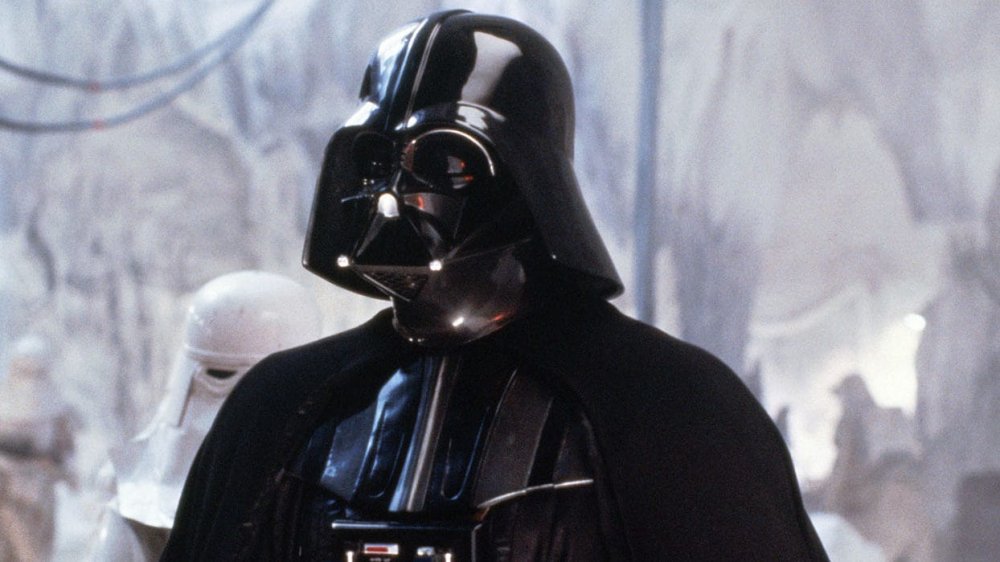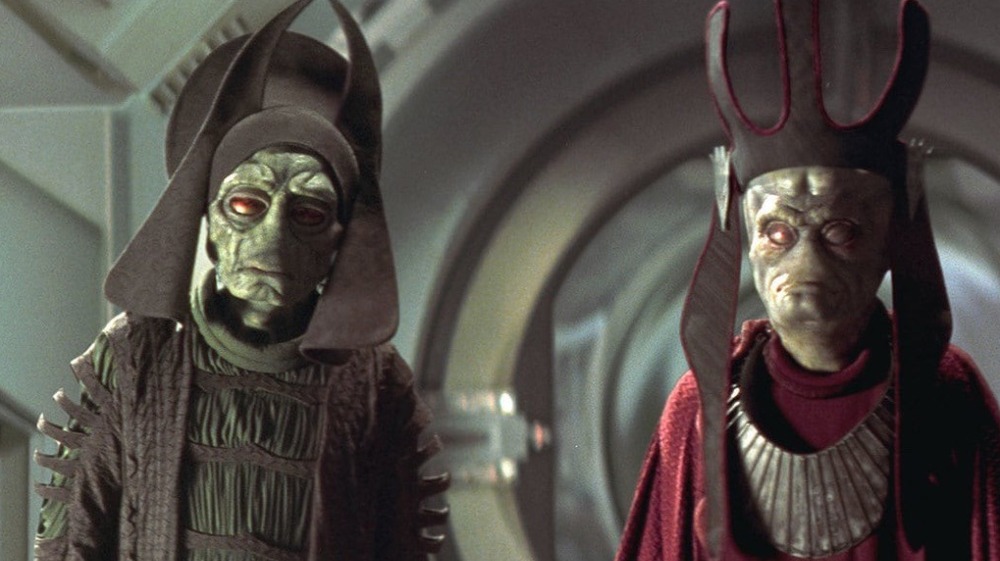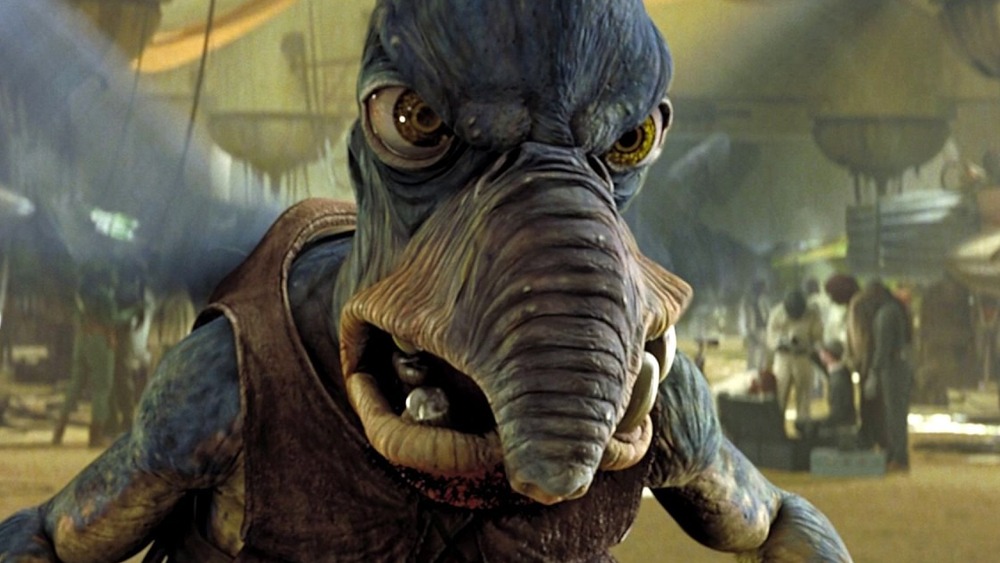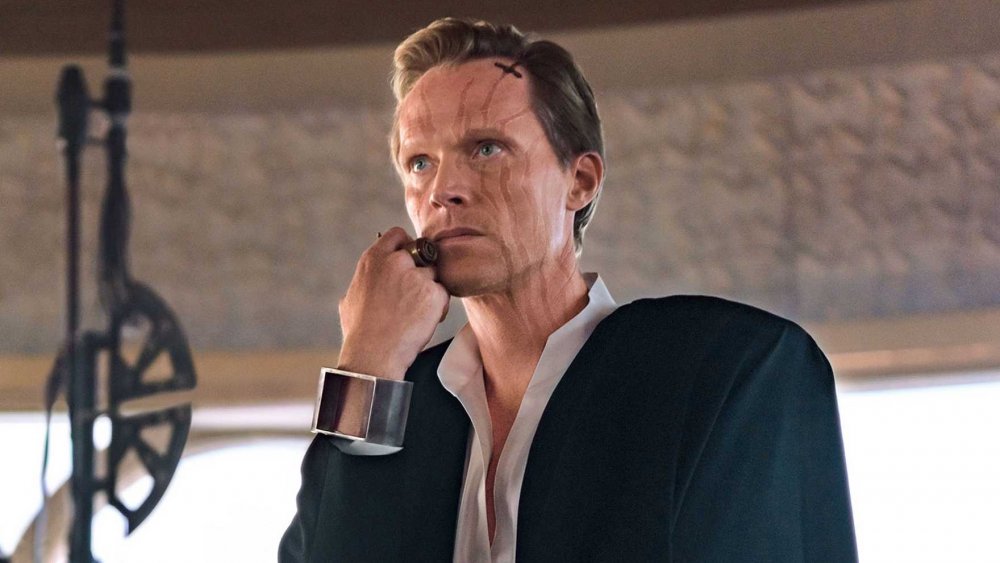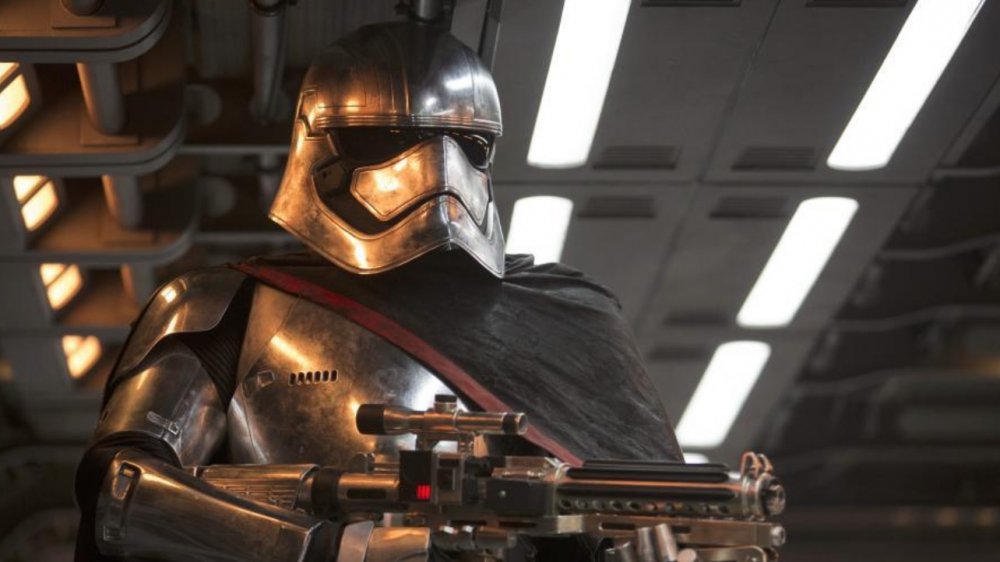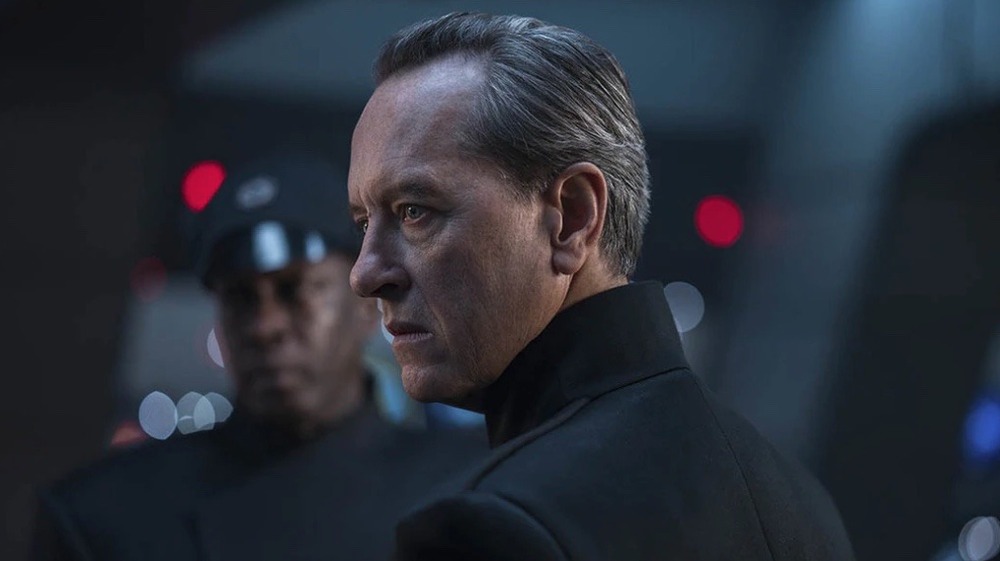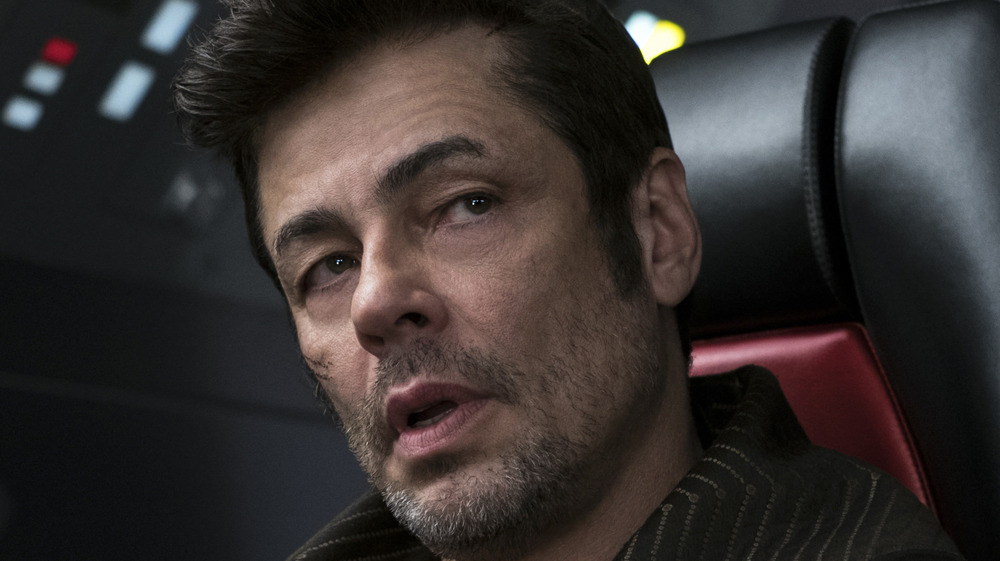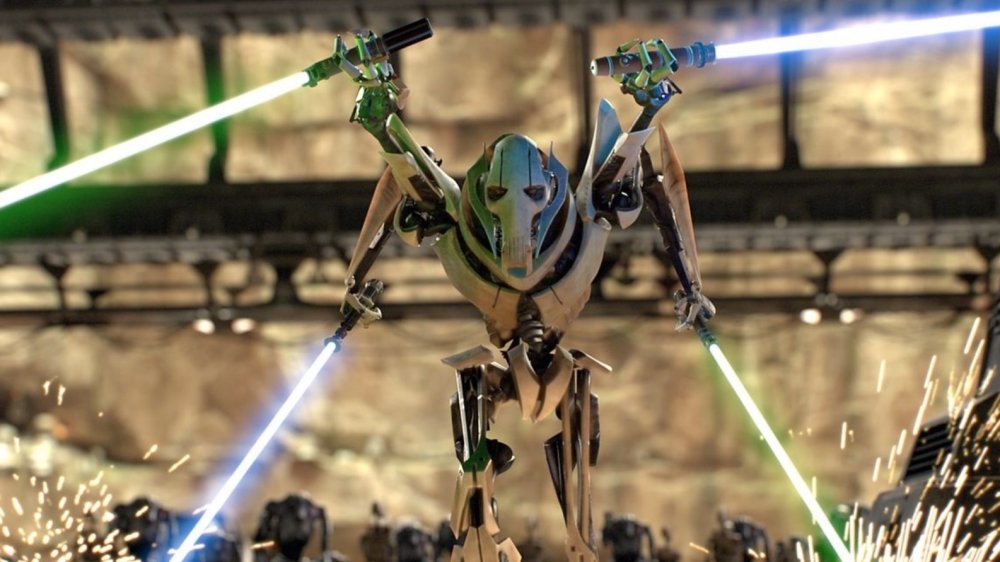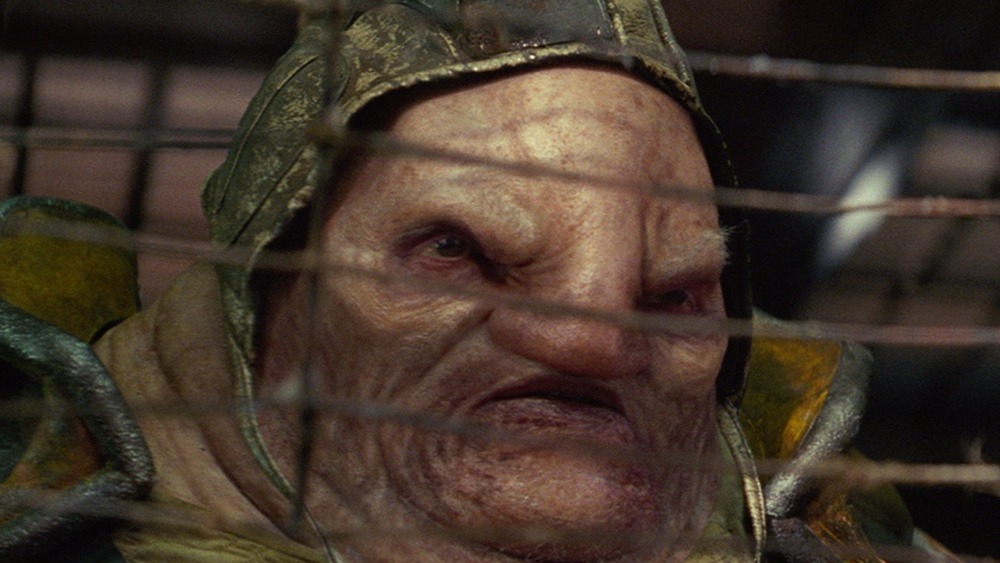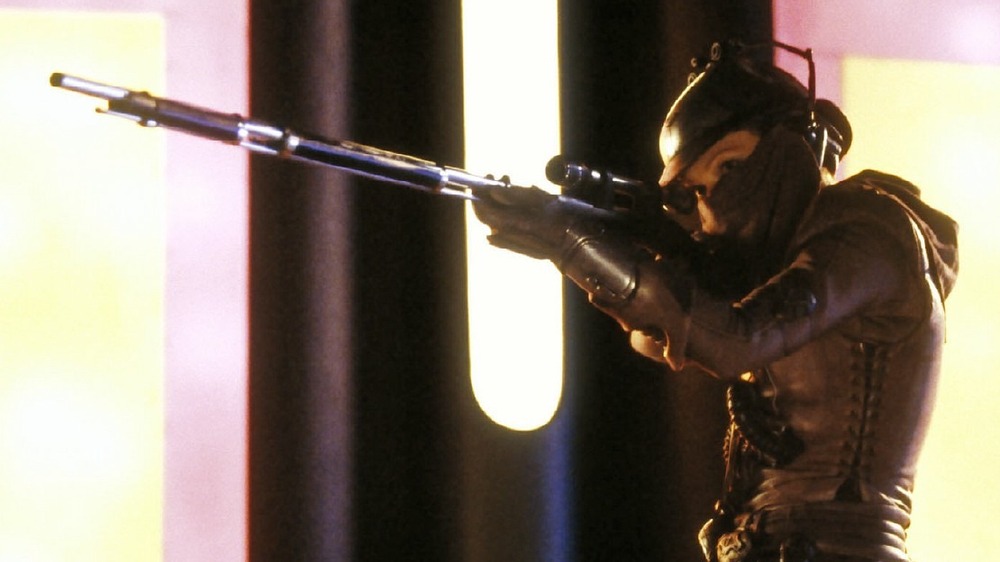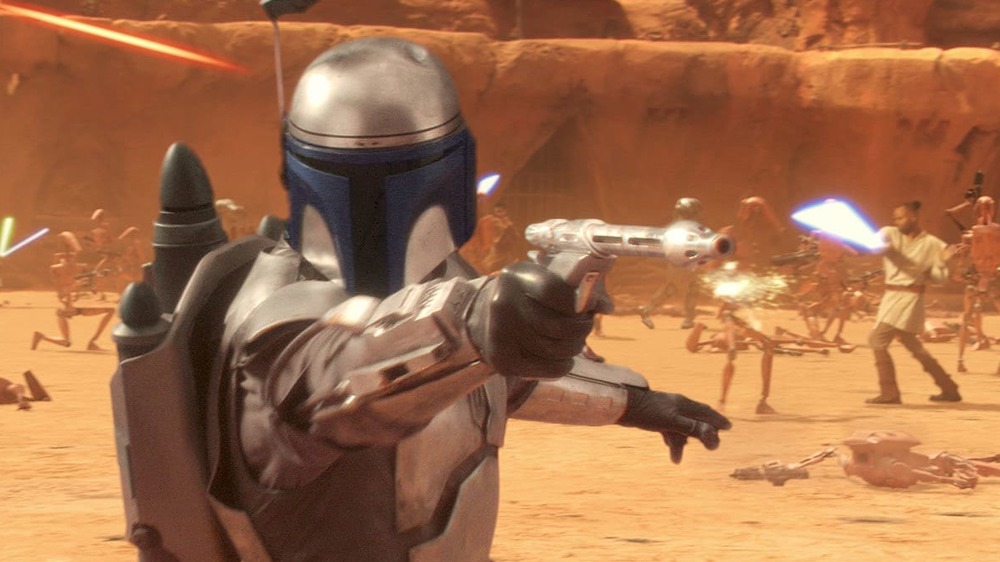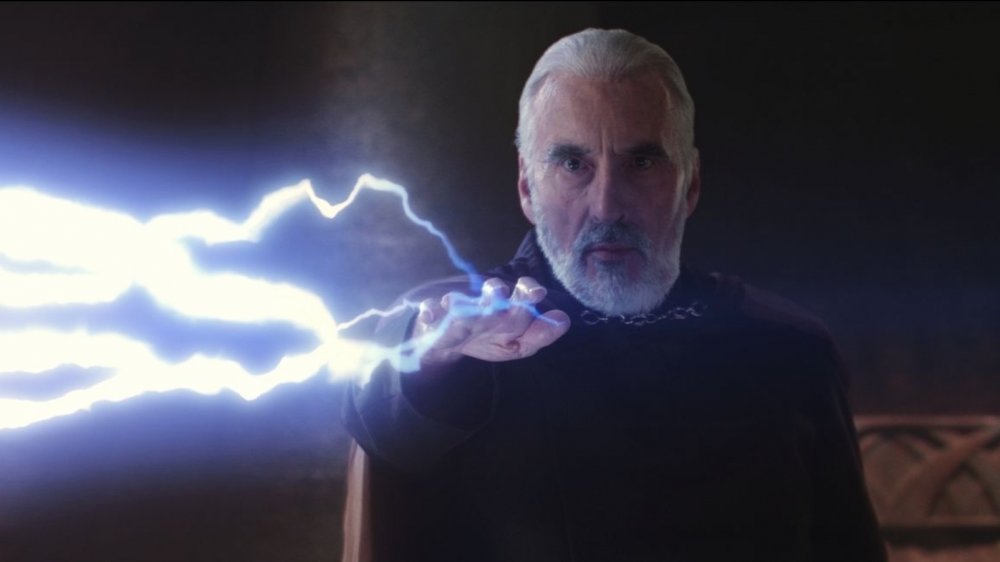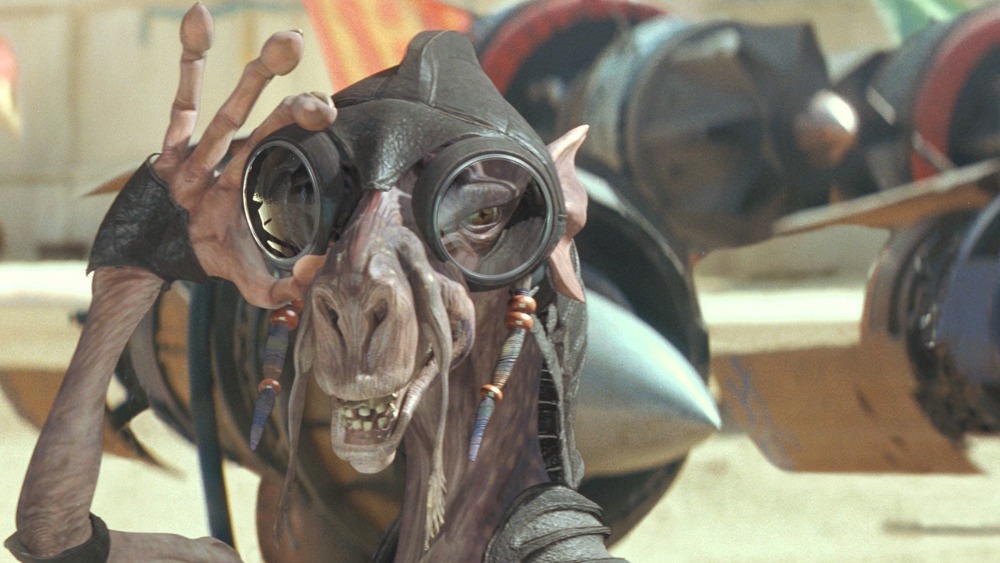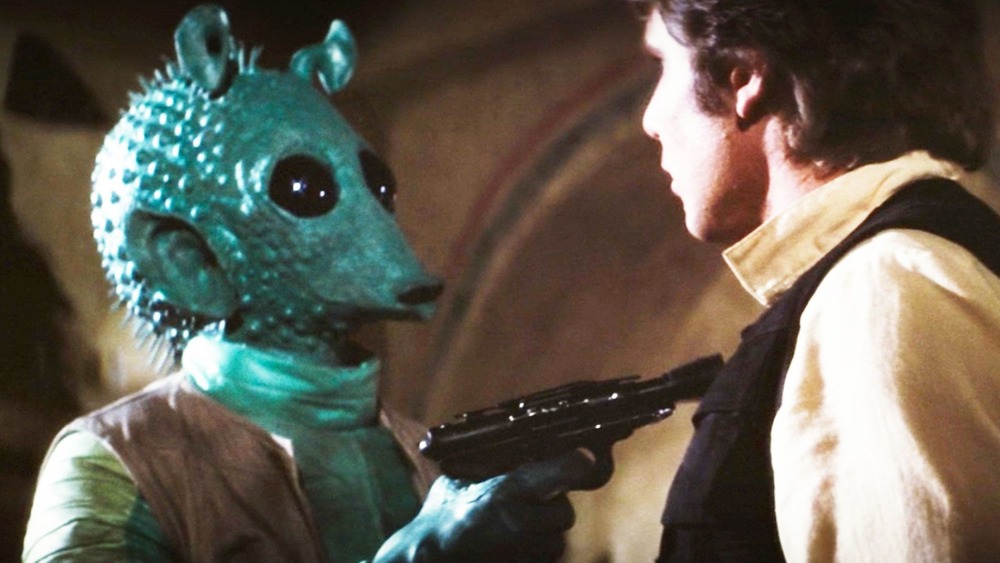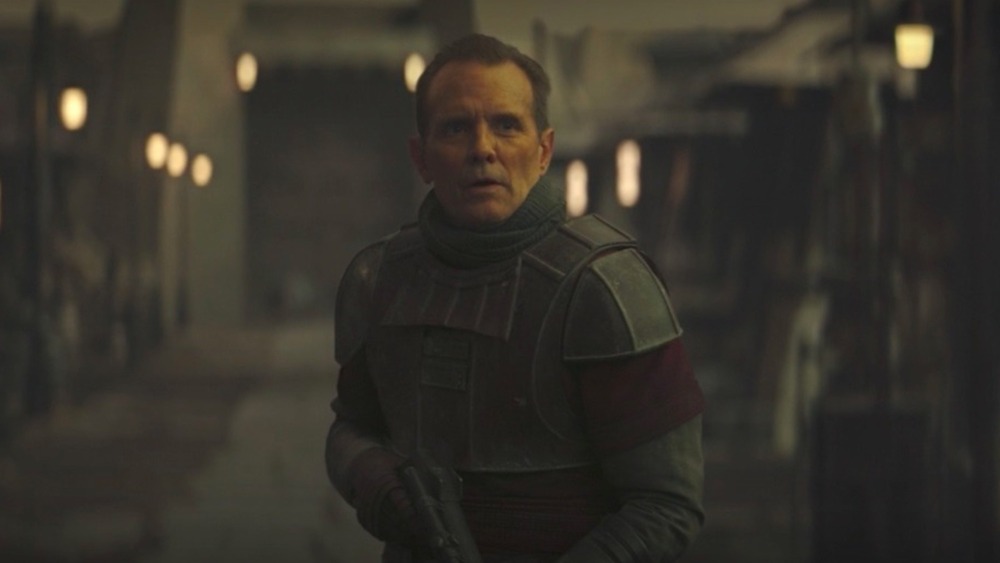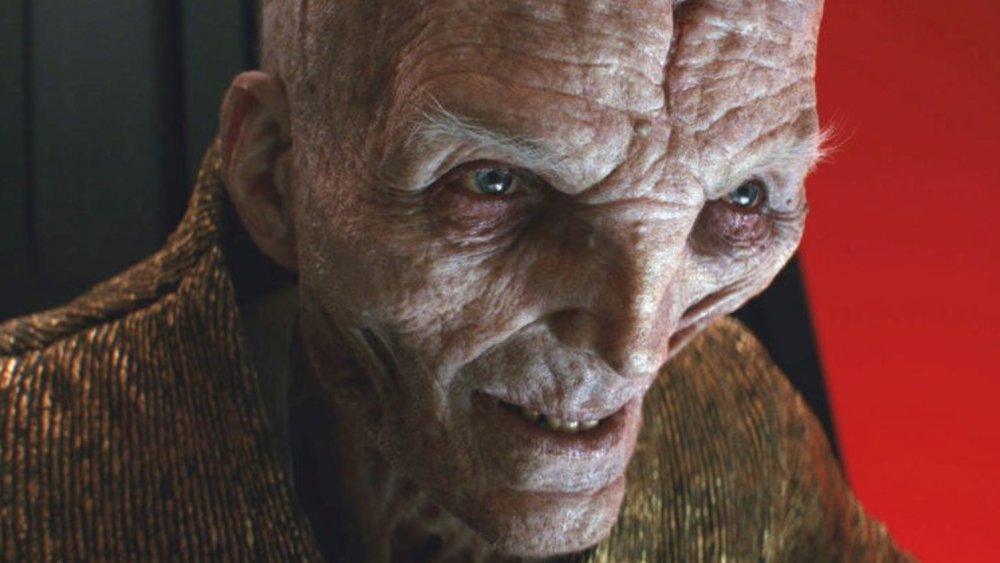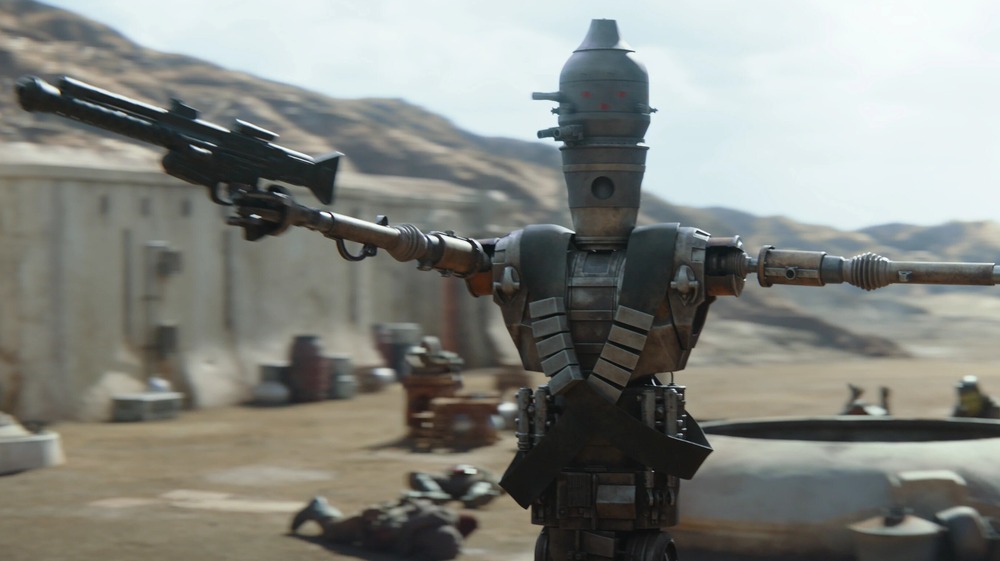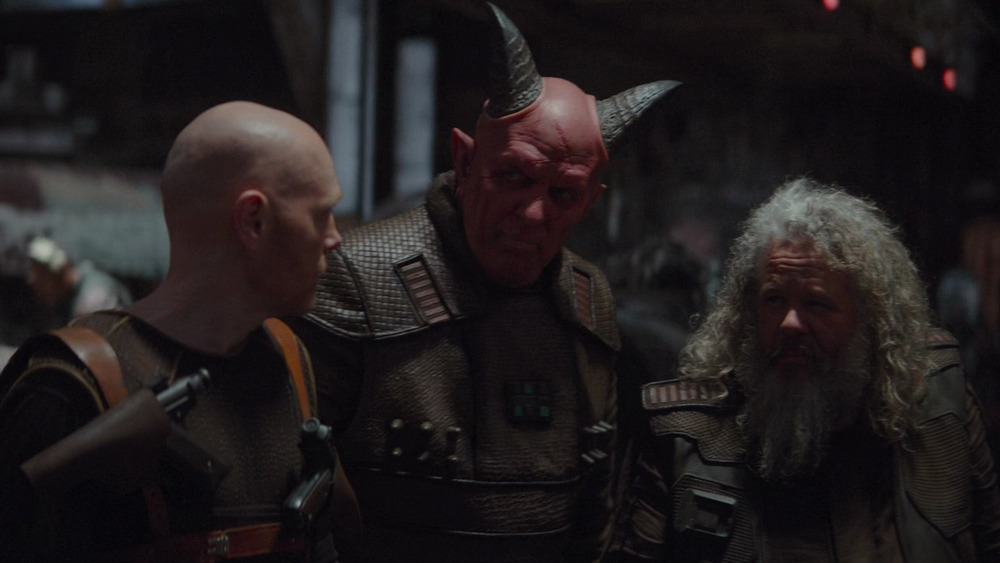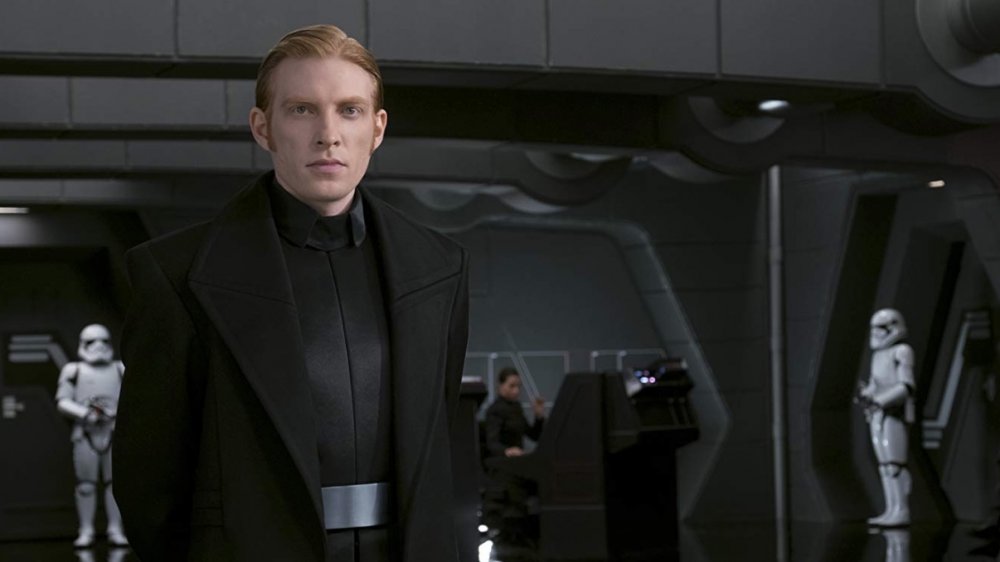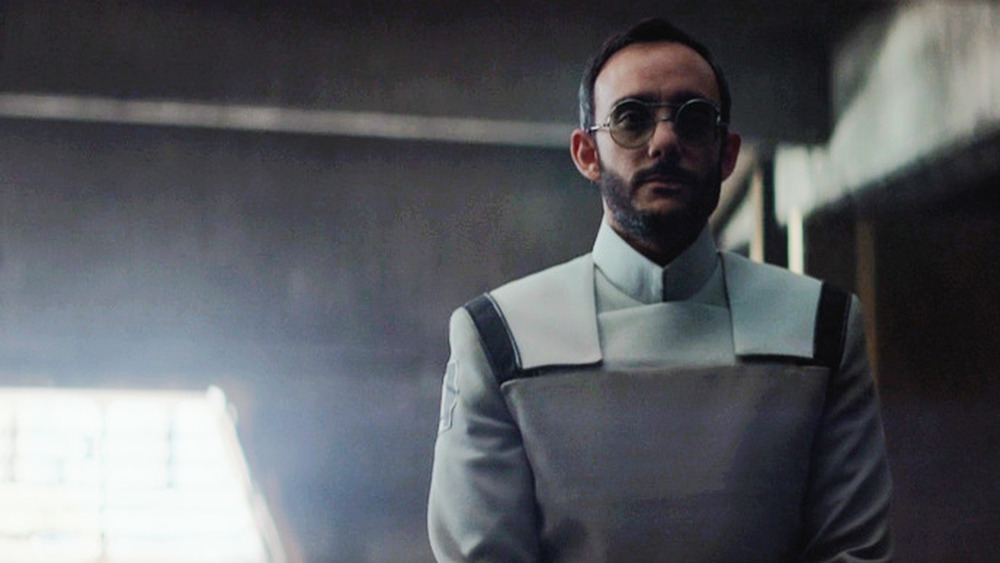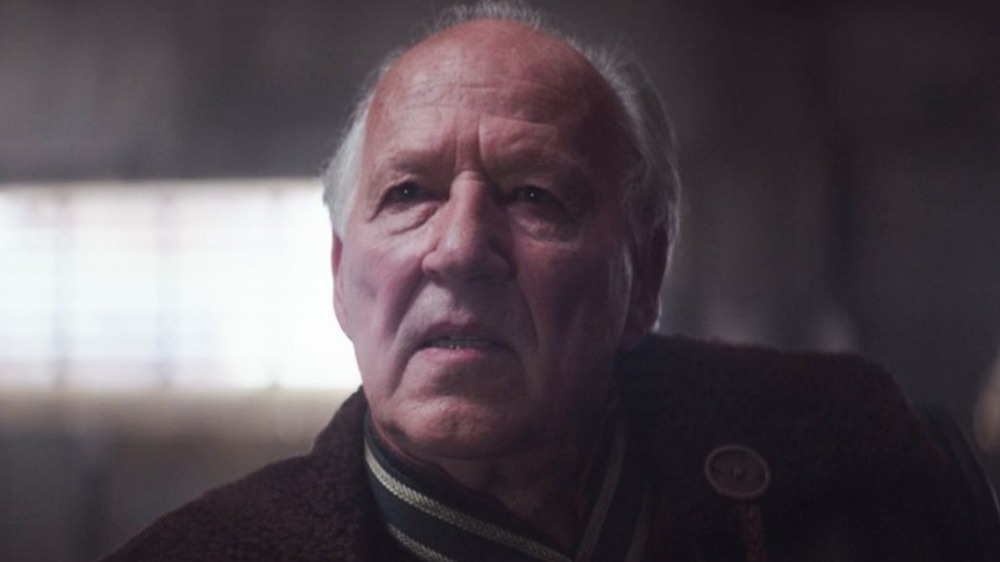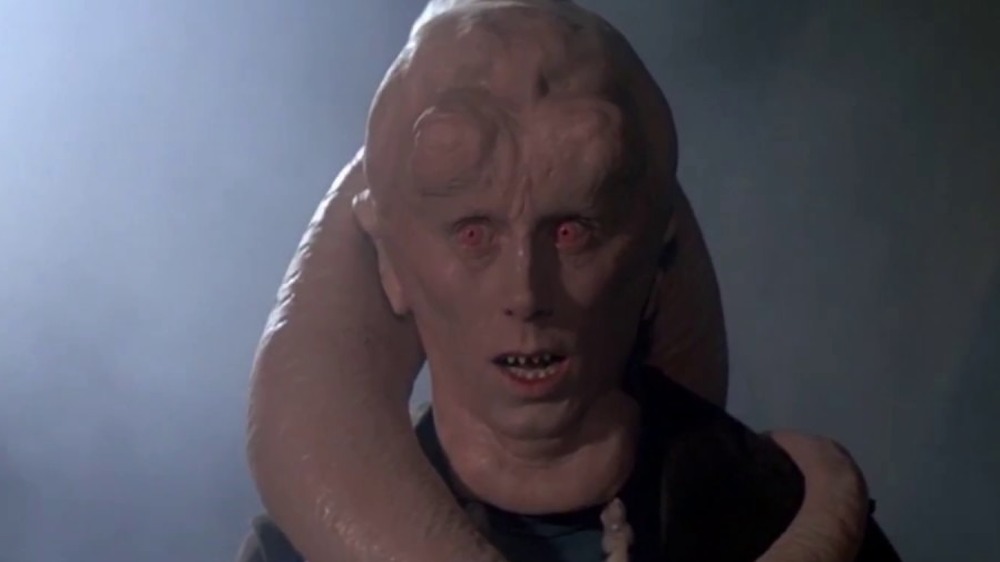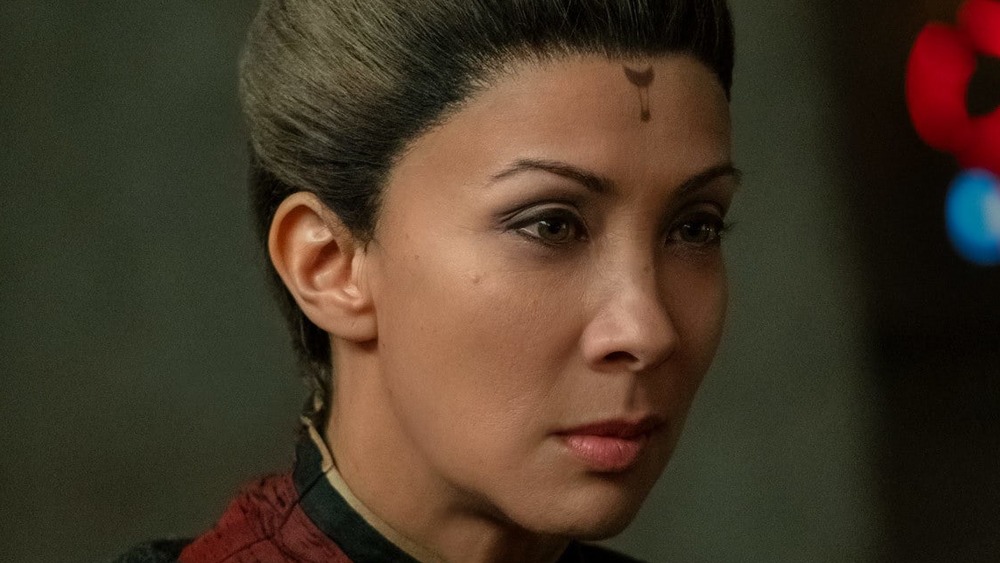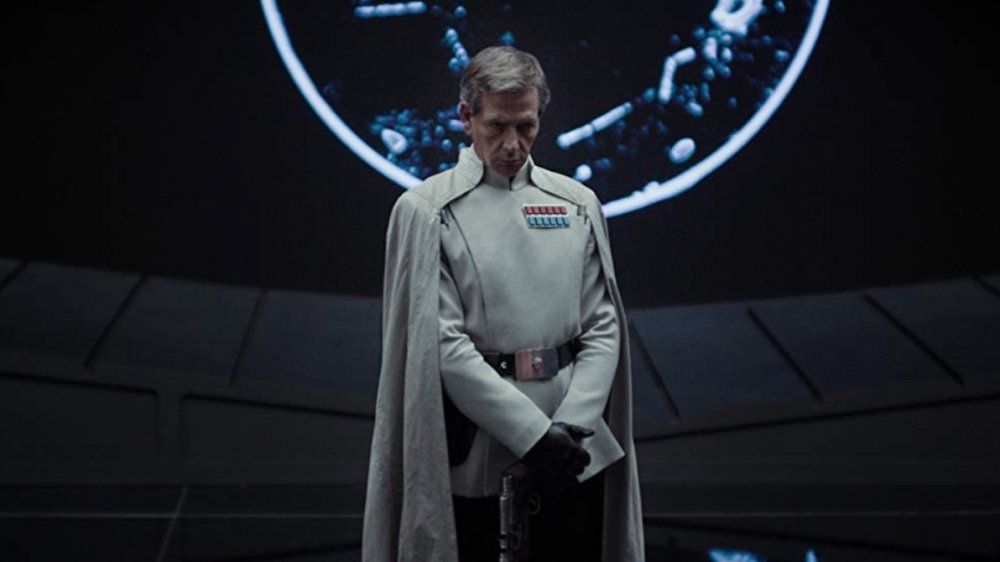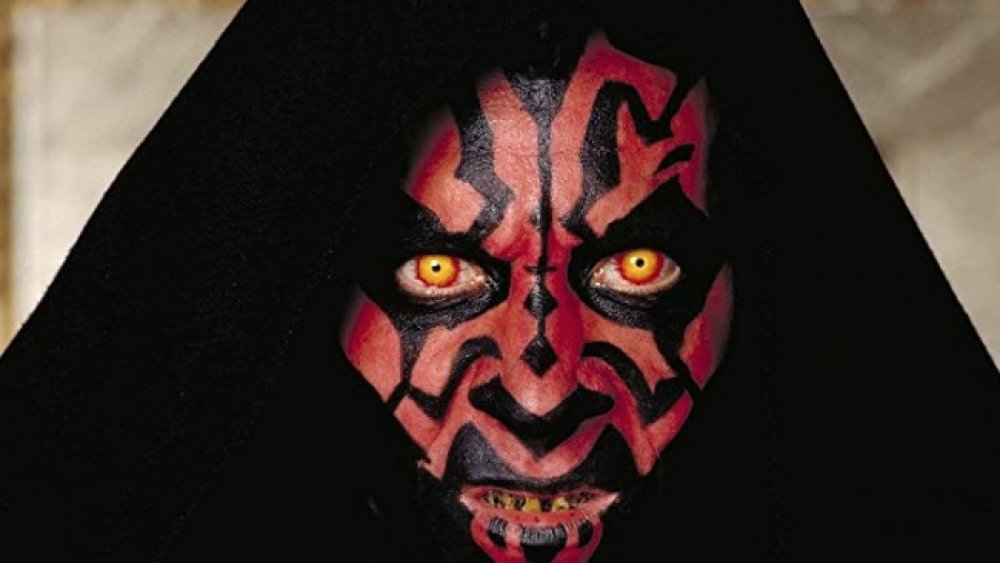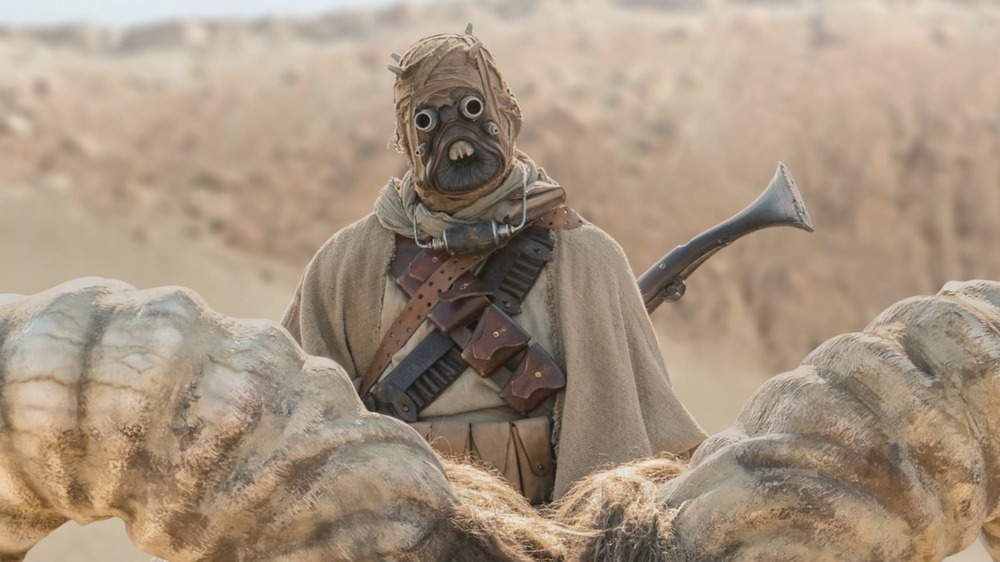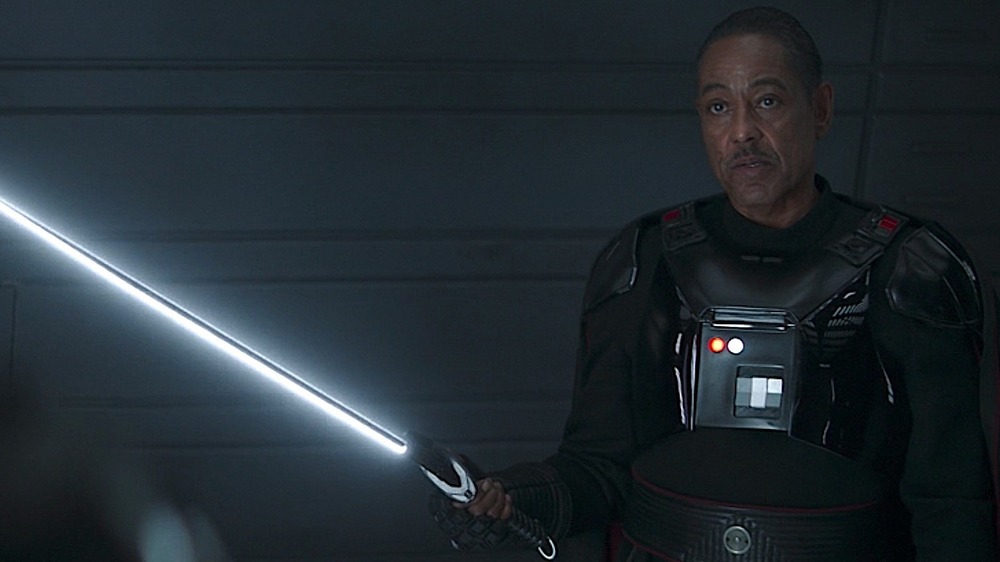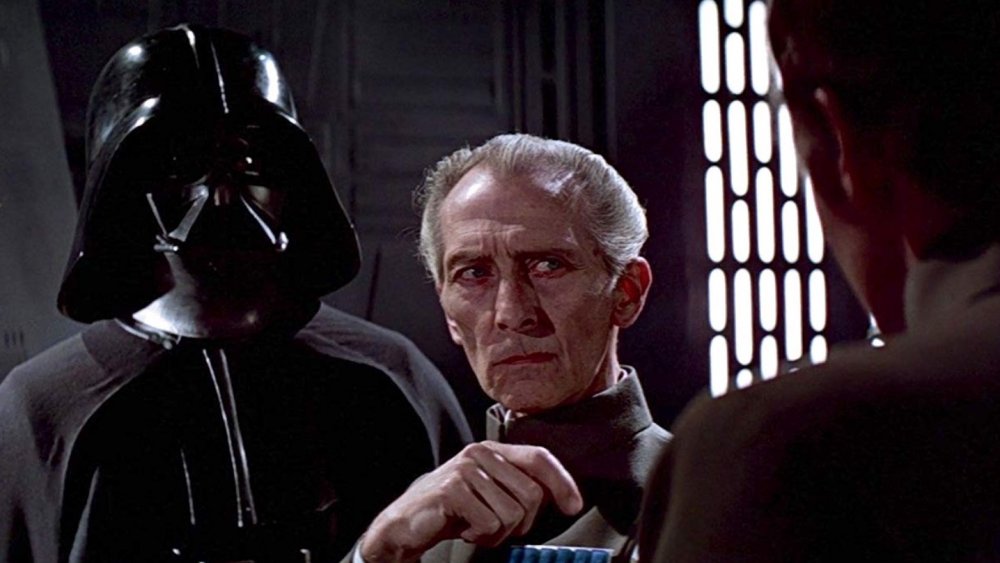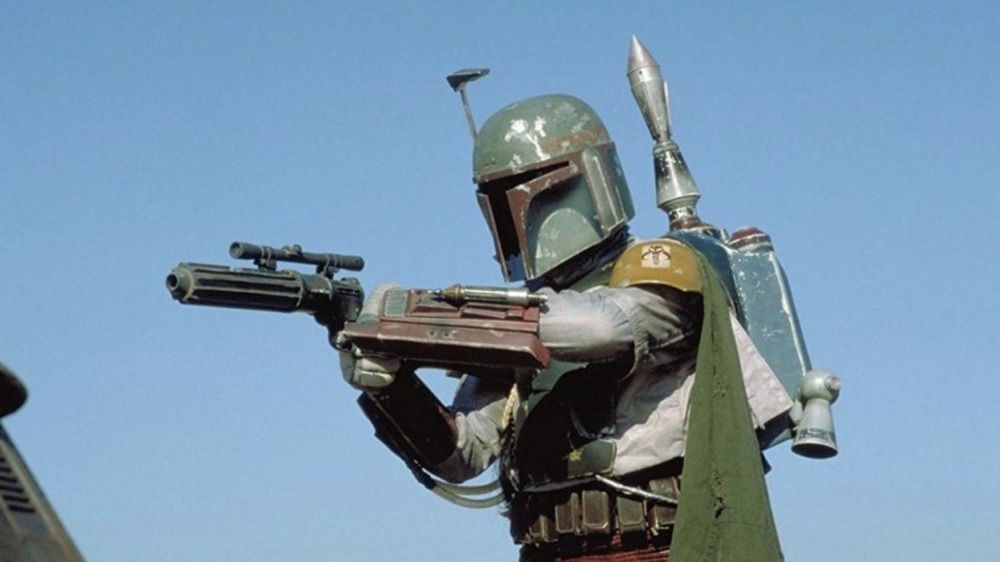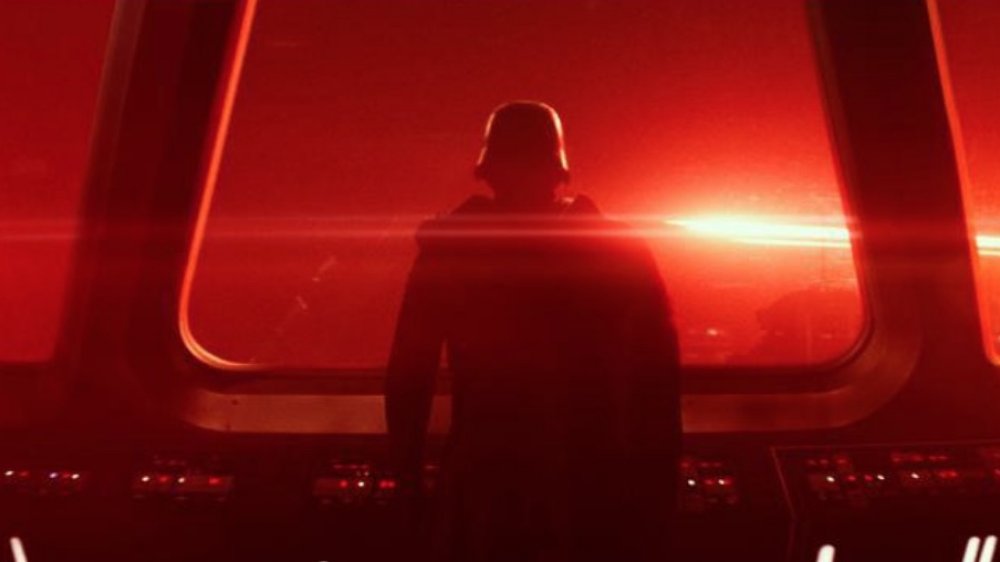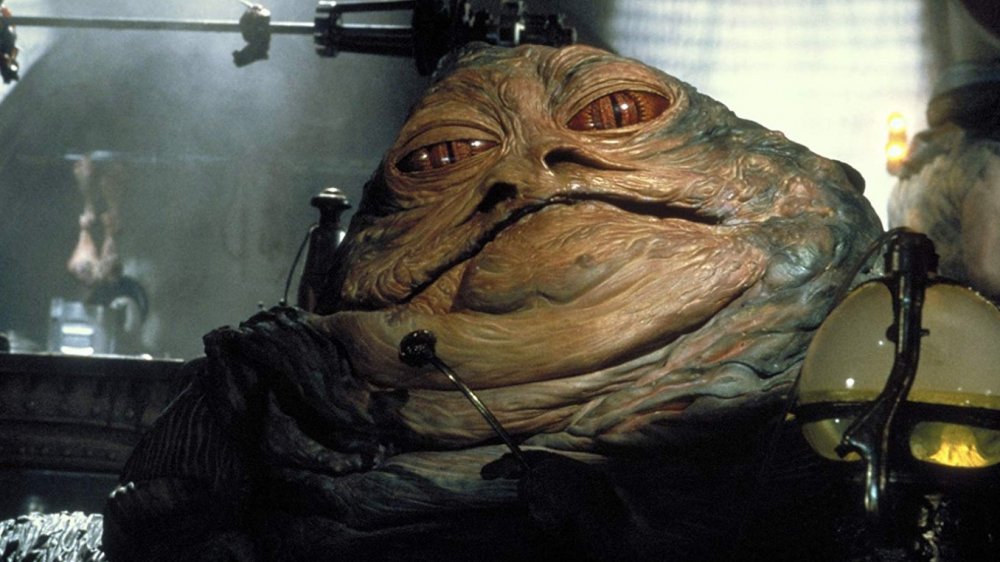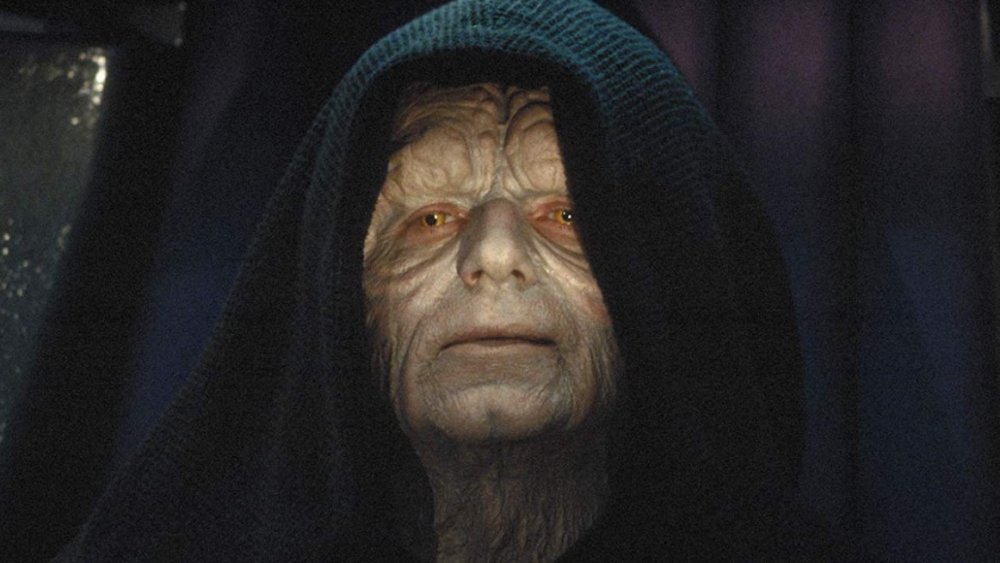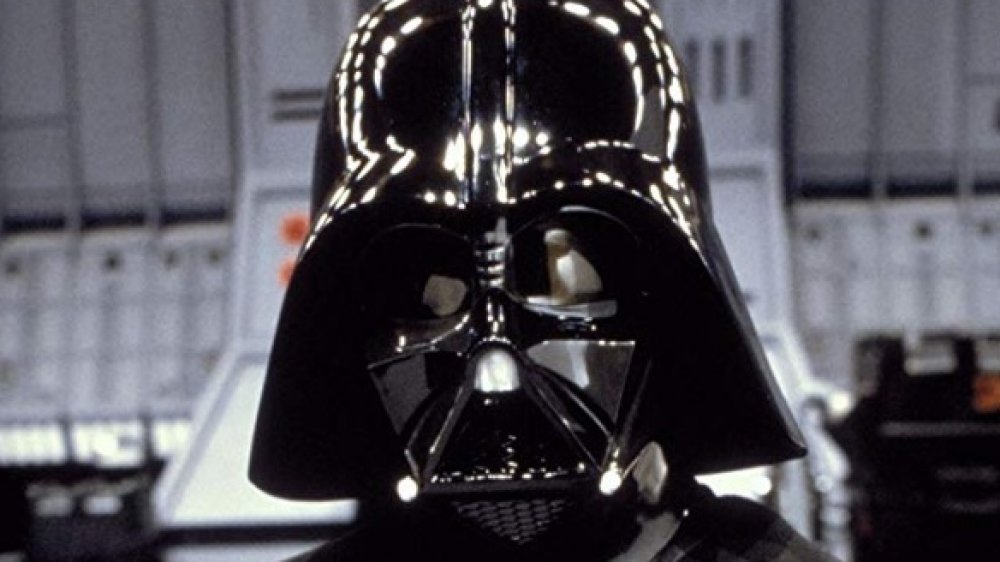Star Wars Live-Action Villains Ranked Worst To Best
In 1977 the little space opera from a galaxy far, far away took the moviegoing universe by storm, selling enough tickets to buy a fleet of Carillion-class Star Destroyers and changing the world in the process. Disguised as science fiction, Star Wars has continued to resonate across ages, cultures, and generations because at its heart Star Wars is truly a classic epic fantasy set in space.
Based largely on the teachings of mythologist Joseph Campbell, Star Wars told a story as old as time, but set it in the future (or "A long time ago..."). Like myths of old, Star Wars is a timeless tale of wide-eyed heroes, dashing rogues, beautiful princesses, and of course, dastardly villains clad in black. You can't have a hero's journey without an assortment of powerful villains to defeat, and Star Wars had some of the best ever. There are many X-factors that played into Star Wars' unprecedented and perhaps improbable success — from John Williams' swashbuckling score to Harrison Ford's dry delivery — but without a doubt the first film and the series it spawned would not have succeeded without its colorful cast of bad guys. Many are some of the best bad guys ever, while others? Not so much. Who are these villains, and what makes them the best at being bad? You don't have to use the Force to find out. Here are the Star Wars movie villains ranked from worst to best!
Boring, racist, and pointless – The trade federation is the worst
The Star Wars prequel trilogy achieved the rare trifecta of being over-complicated, silly, and even offensive. All of these traits were embodied in the Neimoidian Viceroy Nute Gunray, as well as his Trade Federation minions Rune Haako and Dufine. Gunray was Viceroy of the Trade Federation, a member of the Separatist Confederacy of Independent Systems, and Chairman of the Separatist Council, so his days were packed with plenty of Zoom meetings.
Anyway, long story (sort of) short, Gunray was just a pawn in Darth Sidious' plot to overtake the Republic, and was unceremoniously murdered by Darth Vader. For an ultimately meaningless villain, Gunray got a lot of screen time. Was he interesting at least? Yeah, about that. Gunray and his minions were crude Asian stereotypes, speaking in stilted yellow-face impressions straight out of Charlie Chan serials. It's bad. Gunray was the prequel trilogy at its worst — inconsequential, time-consuming, boring, and racist. He clearly earns the title of the worst Star Wars villain.
Watto is hard to watch
Where do we begin with Watto? The bug-like baddie is a greedy Toydarian junk dealer and human trafficker who owned Anakin Skywalker and his mother Shmi in The Phantom Menace, and bears a striking resemblance to Gonzo, if the Muppet's life took a dark turn. Watto is also cringe-inducingly stereotypical. While Jar Jar Binks (who came off like a crude stereotype of Black men not seen since Stepin Fetchit) got most of the public's revulsion, we can't ignore that Watto is absurdly anti-Semitic.
Are we accusing George Lucas of peddling stereotypes? Not exactly, just tone deaf. It's most likely that Lucas' cultural references (for Star Wars especially) are the 1940s serials he watched growing up, and which took stereotypes for granted. While Watto does serve his purpose as a minor foil on Anakin's way to bigger (and less bigoted) things, he'd be much better if he didn't come across as so anti-Semitic.
How a mo-cap space cat became a bland British baddie
Forget about Dryden Vos? Don't worry, we had to Google "Solo villain Paul Bettany" to remember his name too. Dryden Vos isn't a "bad" bad guy, just really bland. And in a universe with slumlord slugs, demonic space ninjas, and Darth flippin' Vader, bland is worse than bad.
Vos is basically just a dude with a British accent, like millions of movie villains before, quite a few of them played by Paul Bettany. Alas, Bettany was not the original actor cast for the part.
When Chris Miller and Phil Lord were directing the film, Vos was going to be played by Boardwalk Empire and The Wire alum Michael K. Williams as a motion-captured feline alien. So, like, Avatar? Alas, Miller and Lord were famously fired from the production, and Williams was unavailable for reshoots. New director Ron Howard was left scrambling, so he turned to Bettany, who he'd worked with on A Beautiful Mind and The Da Vinci Code. With a summer 2018 release date looming, reshooting a costly and time-consuming mo-cap space cat was out.
Inspired by Bettany's performance, Howard opted to give Vos scars that reflected the character's mood. An inspired idea, and probably better than Omar Little playing an alien feline, but not enough to save Solo at the box office, or Dryden Vos from becoming a truly bland Star Wars villain.
Captain Phasma was a fantastic disappointment
Star Wars' stormtroopers are the original Putty Patrol and Foot Clan — ineffective henchmen who serve as no more than a mere nuisance for our heroes before the boss arrives. They also have the worst aim in movies. So we were excited when Gwendolyn Christie, one of the breakout stars from HBO's Game of Thrones, was cast as a senior stormtrooper decked in platinum armor and wearing a cape. Maybe this meant something new for the iconic, but moronic, stormtroopers.
Yeah, not so much. Christie was game, but her Captain Phasma was as irrelevant as any stormtrooper before. Her limited screen time in The Force Awakens basically amounted to bullying John Boyega's Finn before being put into the trash, an apt metaphor. The Last Jedi found Phasma doing nothing notable except falling to her fiery demise, an epic death scene for a character that did not warrant it. Christie deserved better and frankly, the stormtroopers do too. With Captain Phasma, the new trilogy's filmmakers were like stormtroopers themselves; they aimed for greatness and completely missed their shot.
Allegiant General Pryde doesn't inspire much pride
Like much of the Star Wars sequel trilogy, Allegiant General Enric Pryde feels like a great idea the filmmakers came up with at the last minute. A First Order general who served Emperor Palpatine in the Galactic Empire, Pryde would have been a welcome addition to the sequels. Instead the audience is left to wonder why this high-ranking officer was inexplicably missing from The Force Awakens and The Last Jedi. Turns out, Snoke was just keeping him in reserve. Yeah, sure JJ.
Basically, Abrams and company needed a minion to sneer menacingly in The Rise Of Skywalker, and nobody sneers better than Richard E. Grant. We would have liked an actual reason to hate this guy other than he's a villain and it's our obligation, but while Skywalker tries to cram three films worth of Pryde villainy into one, it's too little, too late. By the time General Pryde is vanquished our reaction is less "Yes!" and more, "oh, ok, cool."
DJ didn't do much for us
Even the most boring Star Wars characters at least have memorable names...and then there's DJ. Did Star Wars turn into a '90s sitcom? DJ is short for "Don't Join," representing this amoral arms dealer's ambivalence about the Resistance and First Order. DJ even reveals he's been selling the Resistance black-market weapons, because that's just what this timeless tale of Good vs. Evil needed: snarky moral relativism.
While DJ helps Finn and Tico infiltrate the First Order, he shows his true colors and sells them out. So basically he's Lando, but without any redemption. DJ is an attempt at bringing a fresh take to the Star Wars mythos, but just comes off like a pastiche of edgy villains from other stories, kinda like plugging a Game Of Thrones character into Lord of the Rings. Benicio del Toro is game as always, but the would-be complex character winds up being as basic as his name.
We're still grieving General Grievous' wasted potential
General Grievous has one of the coolest designs in all of Star Wars and could have been one of the best villains. He was a wicked mechanical monstrosity with four lightsaber-wielding arms, as well as a brilliant military strategist and a feared Jedi hunter. He looks like the final boss in the hardest video game you've ever played. But in his one big-screen appearance, Star Wars Episode III: Revenge of the Sith, he is basically just an appetizer who is quickly dispatched by Obi-Wan Kenobi with a few blaster shots to the heart. It's almost an unintentional reference to Raiders of the Lost Ark, when Indy blasts the bad guy spinning the saber with one bullet.
Only this wasn't played for laughs. General Grievous was originally going to be voiced by Gary Oldman, and the man behind Sid Vicious and Jean-Baptiste Zorg would have at least given Grievous some spice. Alas, Oldman pulled out of the production in solidarity with the Screen Actors Guild, though maybe he just realized this evil droid was a dud. General Grievous was instead voiced by Matthew Wood, who sounds like he's merely acting out George Lucas' (a notoriously laissez faire director with actors) instruction to "sound evil." General Grievous fared much better on TV in Star Wars: The Clone Wars, but we're still grieving his wasted potential on the big screen.
Unkar Plutt was underwhelming
Star Wars sure loves greedy junk traders, that's for sure. Case in point, Unkar Plutt, a corpulent Crolutian heavy from the desert planet of Jakku who pesters Rey "Don't Call Me Palpatine" in the first act of The Force Awakens. Personality-wise, he's basically indistinguishable from Watto from The Phantom Menace, except far less anti-Semitic. Plutt's blandness is disappointing, given he's played by scene-stealing English funnyman Simon Pegg, albeit hidden behind a hybrid CG/makeup costume.
Honestly, we kinda think JJ Abrams was just pulling a prank on Pegg by having him work in the scorching desert in a fat suit. A SyFy writer actually argues that Plutt was "The most important Star Wars character of all time..." because he inspired Rey to leave Jakku, but we're not buying it. Maybe Unkar Plutt would be more memorable if they had kept the deleted scene of Chewie ripping his arm off.
Zam Wesell served her purpose
Before the Skrulls of the MCU made shape-shifting green aliens mainstream, there was Zam Wesell of Attack of the Clones. As a Clawdite, Wesell could alter her appearance, which we imagine was super helpful in her profession of bounty hunting. Alas, it didn't afford her much screen time. Wesell was hired to assassinate Senator Padme Amidala, but was stopped by Anakin Skywalker.
Before she could reveal her employer to Skywalker, the Mandolorian/Stormtrooper clone-template Jango Fett shot her with a Kamino saberdart, proving that even in a futuristic sci-fi universe, the ol' "shoot a poison dart into someone about to squeal" method still works like a charm. Maybe we'll see more of her in a future prequel, but for now Wesell is pretty forgettable. Despite being able to change her flesh, Wesell wasn't fully fleshed-out herself, as she was less a character and more of a plot device.
Jango is no Boba
Jango Fett is the lesser of the Fetts. While his son/clone Boba Fett is an iconic villain, Jango Fett's inclusion in Attack of the Clones felt like fan service. Yes, he's one of the most consequential characters in the series, as he was the Mandalorian template who was used to clone the Stormtroopers. But why did he have to be Boba Fett's "dad?" It made the Star Wars universe, which encompasses an entire galaxy with millions of planets and billions of characters, seem small.
It was also a borderline ret-con that was supposed to add depth to Boba Fett, but we liked him better as the mysterious, loner badass with no backstory. Since we can't blame Boba without breaking a Star Wars geek code, we'll take it out on Jango. He's okay, we guess, but personality-wise he's virtually indistinguishable from his "son," and a repeat is always less exciting than the original.
We hope Christopher Lee made bookoos for Dooku
If you ever want to watch a great actor cash a huge check on the big screen, it probably looks like Sir Christopher Lee as Count Dooku in the Star Wars prequels. From Dracula to The Man With The Golden Gun and Saruman in Lord of the Rings, Lee has played the best bad guys ever (he was also a total badass in real life). Alas, Count Dooku isn't one of them.
It didn't have to be this way. Count Dooku was trained by Yoda and trained Qui-Gon Jinn before falling into the dark side of the Force, transforming into Darth Tyranus, and serving as Darth Sidious' apprentice following the death of Darth Maul. Sounds pretty epic, right? Should have been really cool, yeah? Nope. Like so many promising characters and plot lines in the prequel trilogy, Count Dooku was a victim of George Lucas' disorganized and uninspired storytelling. The performance reflects that. Christopher Lee isn't creating a character so much as doing a Christopher Lee impression. You can almost see the dollar signs in his eyes while muttering such groan-inducing lines as "it is obvious this contest cannot be decided by our knowledge of the Force, but our skills with a lightsaber." Good grief. Pretty much nobody but Lee could make that line work, and for that he earned his huge paycheck and our respect, but not a higher place on this list.
Sebulba was a minor foil for Anakin Skywalker
Some Star Wars villains conquer galaxies, others murder millions, and some are just huge bullies. Take Sebulba, the Dugian pod pilot from The Phantom Menace.
Anakin Skywalker's adversary in the Boonta Eve Classic pod-race, Sebulba pulled out every trick he could muster to keep the kid down. As a Dug, Sebulba walks on his hands, but his feet also function like hands, giving him a peculiar gait which evidently didn't interfere with his pod-racing abilities.
As Anakin's slave master Watto tells Jinn: "He always wins!" Not this time, jerk! While Sebulba snuffed several other pilots in the pivotal race, he was bested by Anakin, who won the race and his freedom. Sebulba wasn't an all-time great villain because he wasn't meant to be; he was just filler foil for Anakin. In the Star Wars universe even characters with minimal screen time can shine, but Sebulba is not particularly charismatic, so he was just kinda served his need and faded into obscurity.
Greedo did not shoot first
Greedo is the most iconic inconsequential villain in pop culture history. Seriously, the Rodian bounty hunter has maybe two minutes of screen time, but has come to represent everything right with George Lucas' theatrical versions — and everything wrong with the Special Editions.
In A New Hope, Greedo served his purpose: Establish Han Solo as a badass who was willing to blast bad guys in cold blood. But Lucas had a change of heart between 1977 and 1997, and in the Special Edition he added effects to show Han fired in self-defense. Fans weren't having it, launching the "Han Shot First" controversy, while raising bigger questions about who owns a series — the fans or the creator? Greedo was just a pawn in this larger conversation, so we can't rank him too high. Honestly, if not for the 1997 edit most casual fans wouldn't even know his name.
We wish we could have seen more of Lang
Every villain is a hero in their own story. Well, not every villain (Jabba knows he's a bad dude/slug and doesn't give a flying Kowakian). Like Lang, the Magistrate's Captain of the Guard for Morgan Elsbeth in the Season 2 episode of The Mandalorian, "The Jedi." We don't know much about Lang's backstory from either the show or other sources, a rarity in Star Wars mythology, though Mando speculated Lang was once part of a military faction.
Maybe Mando just recognized the actor who played Lang — Michael Biehn, most famous for playing the intense Kyle Reese in The Terminator. Biehn has had the "noble soldier with an edge" schtick down pat since the mid-1980s, and he brings it to Lang. What he lacked in screen time, he made up in presence.
Snoke was an Emperor clone who turned out to be a clone
With the Emperor vanquished and Darth Vader redeemed (and also vanquished) who would, or could, possibly replace them as the new trilogy's "big bad?" Could it be Grand Admiral Thrawn? Prince Xizor? Or a new character entirely? We got our answer when The Force Awakens was released on December 18, 2015 and revealed the new "big bad" was... basically just the Emperor.
Snoke isn't a bad villain, but a weak imitation of a much better one, Emperor Palpatine. The potential was there for an interesting backstory or compelling character motivation: Why the burn scars? What kind of creature is he? Who trained him? How did he seduce Ben Solo to the dark side? What does he even want? While some of these questions were answered in comics and novelizations, the movies were like "who cares?" while fans said: "uh, we do."
The Last Jedi writer/director Rian Johnson took a creative risk and rather than invest further screen time in this villain, he had the much more interesting Kylo Ren slice him in half. A bold move, but one that only served to reinforce Snoke's irrelevance. He truly was just an Emperor clone. JJ Abrams said "hold my Fuzzy Tauntaun" and in Rise of the Skywalker informed us that Snoke was literally a clone. Snoke's not the worst "big bad" in pop culture, but a far cry from his predecessor, or the much better alternatives.
The IG robots were the evil droids we were looking for
Droids are a huge part of Star Wars. George Lucas even said the series was told from R2-D2's POV. However, droids are usually there to be adorable (BB-8) or comical (C-3PO). It's rare they make memorable villains. Yes, the droid army were the villains in the Clone Wars (albeit via Senator Palpatine's behind-the-scenes shenanigans), but as far as one singular droid, the field is scarce.
Then there's IG-88B and IG-11. While they're "different" characters, robots are basically the same. Both are heavily featured in Star Wars comics, novels, etc., but as far as the live-action series, IG-88B was one of Boba Fett's rivals in capturing Han Solo, while IG-11 competed with Mando to capture The Child in The Mandalorian. IG-11 got more screen time than IG-88B, and gave fans a glimpse into what a cold-blooded (make that no-blooded) bad guy the IG's can be.
Ranzar Malk and his mercenaries were solid single-episode villains
When you lie down with dogs, you wake up with fleas. Or in Star Wars lingo, you hang with ruthless space mercenaries, you may not wake up at all. A villain on the Season 1 episode of The Mandalorian, "The Prisoner," Ranzar Malk (played by Mark Boone Junior) was a former associate of Mando who hired the bounty hunter to help his mercenaries (including Clancy Brown's Burg and Natalia Gastiain Tena as Xi'an) break out a Twi'lek criminal named Qin, who was being held on a New Republic prison vessel.
But villains gonna' villain, and once Mando helped Malk's mercenaries bust out Qin, they betrayed him. Big mistake.
Mando took out the mercenaries one-by-one, Batman style, before placing a tracking beacon with Malk, making him a target of New Republic X-Wing starfighters. Now, Malk and his mercenaries may seem like small potatoes on a list with some of the greatest villains of all time, but for single-episode TV show villains, they were solid.
General Hux was your typical toadie
Every hero needs their villain, and every villain needs his sniveling weasel. The sniveling weasel is the bad guy equivalent of the good guy's "best friend." Enter General Hux. While we got hints that General Hux might be more than your typical toadie, and perhaps even a threat to Kylo Ren's second-in-command status, it never went anywhere. Their clear animosity was an interesting and unexpected contrast to the "every bad guy gets along" nature of the original trilogy. Alas, that potential was never really explored, and by the time Snoke was killed by Kylo Ren in The Last Jedi, General Hux was relegated to being a punching bag for Kylo Ren, and a punchline for the audience.
The Rise of Skywalker nearly redeemed General Hux (as a character and perhaps as a hero as well) when it was revealed he was the spy who had been informing the Resistance. His motivation made sense: he had to stop Kylo Ren by any means necessary. But The Rise of Skywalker was more concerned with Kylo's redemption narrative, so Hux was quickly blasted away by Richard E. Grant's General Pryde, an "insert new Grand Moff Tarkin here" who is such an inert character he doesn't even make this list. Kudos to Domhnall Gleeson, who does a pretty splendid job as a sniveling weasel. Shame that's all he got to do.
Doctor Pershing was the mad scientist in The Mandalorian
Star Wars has put its distinct spin on all sorts of classic villain tropes: The slimy mob boss (Jabba); the silent gunman (Boba Fett); the militaristic madman (Grand Moff Tarkin); and of course, the wicked wizard (the Sith). But Doctor Pershing in The Mandalorian is one of the only examples of the mad scientist. Doctor Pershing is an Imperial clone engineer during the New Republic, who along with The Client hired Mando to capture The Child.
While Doctor Pershing performed experiments on The Child, he claimed to have spared the baby's life, and gave him back to Mando. In the second season, Doctor Pershing even gave Mando and Cara Dune valuable intel on Moff Gideon's ship. So Doctor Pershing isn't just any mad scientist; he's a mad scientist with a heart of gold. Doctor Pershing is a valuable addition to the series, constantly keeping fans guessing what he'll do next.
Werner Herzog makes The Client so dastardly
Maybe it's his German accent, malevolent mannerisms, or propensity to speak in vaguely disquieting platitudes about the pointlessness of existence, but Werner Herzog makes a great villain because he does all that stuff anyway. Of course, his long-time collaborator, the late Klaus Kinski could have told you that. As the godfather of the New German Cinema, seeing the ruthlessly independent, anti-authoritarian director Werner Herzog in a Disney-owned Star Wars property is so surreal it borders on satire.
And yet, he's just so good as the mysterious Mandalorian villain The Client. Herzog built his considerable cinematic legend on being a madman, but his screen persona is more subtle and methodical, which works for The Client, an associate of the Galactic Empire who hires Mando to kidnap The Child. Who would want to kill Baby Yoda!?! Werner Herzog. We're not sure we'd be as into The Client if he were played by someone else, which just proves how brilliant casting Herzog was.
Bib Fortuna is one of the most memorable minions ever
Not every great villain has to be a "Big Bad" or even an "Boss Level" baddie. Bib Fortuna proves a memorable minion can make his mark too. Fortuna was a multilingual Twi'lek who served as Jabba The Hutt's chief of staff and majordomo (chief steward to a great household) until the big slug was blown up in Return of the Jedi. Fans thought Bib bit it too until he showed up in The Mandalorian, where it was revealed that he survived and had been ruling Jabba's crime empire...and then Boba Fett promptly blew him away. Tough break.
What makes Bib so charismatic? Where to begin? His ghostly white flesh, for starters. His ponytail-esque head-tail doesn't hurt. Then there is his icky voice, with words slithering out of his mouth like snails. We bet Bib Fortuna was partially inspired by J.R.R. Tolkien's "Mouth of Sauron," and he certainly belongs in the same conversation for "Most Memorable Minion Ever."
We hope to see more of Morgan Elsbeth
Morgan Elsbeth is one bad dudette, and not just because she ran afoul of longtime fan favorite Ahsoka Tano. As Elsbeth told Tano: "The lives of these citizens mean nothing to me. Now, because of you, these people will suffer." Not the most populist speech we've heard, but as the Imperial magistrate of Calodan on the planet Corvus, Elsbeth didn't need to worry about re-election.
Elsbeth hired Mando to kill Tano in the Season 2 episode of The Mandalorian, "The Jedi," but he teamed up with the Jedi instead to defeat and unseat the tyrant. We learned from Tano that Elsbeth lost her family during the Clone Wars, and her rage fueled her drive to help with the construction of the Imperial Navy. Elsbeth certainly caught our attention, and we're hoping to see more of her down the line, hopefully in service to her master, Grand Admiral Thrawn.
Orson Krennic is better than your average weasel
Ben Mendelsohn harkens back to the character actors of old, like Peter Lorre or Claude Rains, who played villains 96.7% of their careers, not due to a lack of versatility, but because they were so darn good at being bad. Consequently Mendelsohn's Orson Krennic is better than your average weasel. Granted, Rogue One: A Star Wars Story is arguably the best of the Disney batch of Star Wars films, and gives Mendelsohn way more scenery to chew than Domhnall Gleeson had with General Hux.
He's also just a fresher take on the toadie trope. Krennic's not a General, Admiral or Grand Moff. He's Director of the Imperial Military Department of Advanced Weapons Research, a brilliantly banal bureaucratic title that sounds like a real job and speaks to his lower status on the Empire's org chart. It's his callous ambition to rise up the ranks that makes him so believable, as he frequently butts heads with his boss, Grand Moff Tarkin. Rather than a monolithic, omnipotent bad guy, it's exciting to see flawed villains who compete for influence and make fatal errors based on their own blind ambition. We only got to see Orson Krennic in one film, and he was perfect for it, but he would have been quite welcome in the General Hux position in the new trilogy.
Darth Maul was a devil who deserved better
Perhaps the biggest victim of George Lucas' mediocre prequel trilogy was Darth Maul. With his Crouching Tiger, Hidden Dragon grace and snarling, Satanic visage, Darth Maul is probably the best part of the prequel trilogy. He was certainly the most threatening, with a double-bladed lightsaber he handled with the ease of a professional baton twirler. No wonder Darth Maul seemed like the most popular Halloween costume for three years running; dude's a badass. He stalks the heroes in The Phantom Menace like a predatory animal, creating dread every time he appears. You're legitimately scared the characters won't get out alive. And Qui-Gon Jinn does not, as Darth Maul impales Jinn to create the prequel's first, and maybe only, emotional moment.
Imagine what could have been: Obi-Wan Kenobi and Anakin Skywalker seeking vengeance against the vicious apprentice to the shadowy Darth Sidious who murdered their mentor, before Anakin Skywalker finally succumbs to the Dark Side and murders Darth Maul, becoming Darth Vader in the process. Alas, George Lucas had other plans, as Kenobi quickly disposed of Darth Maul just minutes after Jinn's murder, avenging and replacing his defeated mentor. Turns out Darth Maul was still alive as he returned in Star Wars: Rebels and as leader of the criminal organization Crimson Dawn in Solo: A Star Wars Story. Hopefully he'll get a proper storyline (and a higher place on this list) in the Kenobi series on Disney+.
Tusken Raiders are an ever-present menace
One of the most iconic villains in the entire Star Wars universe isn't one villain at all. It's the Tusken Raiders (aka Sand People), who appeared in A New Hope, The Phantom Menace, Attack of the Clones, and The Mandalorian. Who can forget watching Star Wars (as us old timers call Episode IV) for the first time as a kid and being terrified by these faceless, nameless, cackling foes?
The Tuskens were pretty important to the story too, as they introduced us to Obi-Wan "Ben" Kenobi in A New Hope, and then later (er, earlier) in the prequel Attack of the Clones caused Anakin Skywalker to snap when they murdered his mother. What makes the Tuskens so memorable, and so threatening, is they're not individuals; they're just this mass of menace that shows up to wreak havoc. The Tusken Raiders are one of the characters that make Star Wars, well, "Star Wars."
Moff Gideon is another great villain in Giancarlo Esposito's career
Following his terrifying, unforgettable turn as Gus Fring in Breaking Bad, casting Giancarlo Esposito as The Mandalorian's "big bad" Moff Gideon may strike some as predictable or cliche. We disagree. Nobody is as good at being bad as Esposito, whether he's selling chicken wings and methamphetamines, or slaughtering innocent civilians in his single-minded pursuit of The Child. While Esposito's Fring was the strong, silent, psychotic type in Breaking Bad, his Moff Gideon is the classic, mustache-twirling villain, which is absolutely perfect for a space western like The Mandalorian.
Honestly, giving Moff Gideon nuance would be wrong — the dude wants to steal The Child's blood! No shades of gray there, he's literally harvesting the cutest character ever, like if someone used Baby Groot for firewood. Esposito knows his role and plays it to perfection, harkening the Star Wars series back to its roots as a "Good vs. Evil" fantasy epic in space.
Peter Cushing crushed it as the wicked Grand Moff Tarkin
It's one thing to be threatening when you can strangle people with your mind, wield a lightsaber like a samurai, or shoot lightning beams from your fingers. But to be threatening with just a glance? That's impressive. Grand Moff Tarkin is the best non-Force wielding villain in the Empire, full stop. Remember when Darth Vader was choking out that incompetent underling and Tarkin told him to stop — and he did? As a kid watching it you're thinking: "wow, even Darth Vader listens to that dude!"
Give it up to veteran Hammer horror film actor Peter Cushing, who takes what could have been an "insert bad guy with British accent here" and makes him a highlight of the series. Much like Sir Alec Guinness gave credibility to Star Wars by playing Obi-Wan Kenobi straight, Cushing did the same with Tarkin. No tongues-in-cheek or eye-winking here. This is an actor 100% committed to his role as a vicious tyrant (even if he was wearing slippers while blowing up Alderaan.) Cushing was so impressive and irreplaceable he was "brought back" for the prequel Rogue One: A Star Wars Story in 2016, despite dying 22 years earlier in 1994. We can debate the ethics or creep factor of bringing back a dead actor to reprise his most famous role, but one thing is for certain: Peter Cushing's Grand Moff Tarkin was a great villain.
Boba Fett was a Man(dalorian) of action
Boba Fett may be the most successful bit player in movie history.
Yes, he is the badass bounty hunter who captured Han Solo. For decades, however, that felt watered down by one of the weakest death scenes in the series, with Han accidentally sending Fett flying into the mouth of the Sarlacc. Yet, despite his minimal screen time, he was undoubtedly a fan favorites. The reason? Maybe it was all that detailed armor, or the weaponry we barely got a chance to see in action. It seemed, for sure, there had to be a story behind it all.
So, Disney+ launched their streamer with the wildly popular The Mandalorian, and Boba is back. While its main character is a different guy who only looks a bit like Boba, it could now easily be retitled "The Boba Fett & Baby Yoda Show." It was only appropriate when Boba Fett showed up in Season 2, finally getting his redemption and showing that no malfunctioning jetpack could take him down. He has returned as the anti-hero we all wanted for decades, and closed the season by blowing away Bib Fortuna to steal the throne of his former boss, Jabba The Hutt. Already an icon, Boba Fett will always be cooler than a Carbonite deep freeze.
Kylo Ren gave us a different kind of bad guy
How do you follow up two of the greatest villains in Star Wars, Emperor Palpatine and Darth Vader? Answer: you don't. Adam Driver understood this. His Kylo Ren could have easily become Vader Lite, but thanks to Driver's uncompromising conviction, Kylo Ren becomes something else entirely. No, Kylo Ren could not have existed without Darth Vader, but that plays into his persona. Where Darth Vader was confident and capable piloting a tie fighter, wielding a lightsaber, and commanding an army, his grandson is an angry, impulsive brat who is willing to kill his own flesh-and-blood and massacre billions to get the respect he's never actually earned. He's like Joe Pesci in Goodfellas, a loose cannon who's threatening not because he's mastered his powers, but because he's reckless with them. From destroying a command station to impaling his father and slicing Snoke in half, this is not a guy who thinks before he acts. Yet he also has moments of tenderness and pathos, as when he can't pull the trigger on his mother. Yes, the redemption narrative in Rise of the Skywalker feels like a ripoff of Return of the Jedi, but while the story feels repetitive, Driver's nuanced, thoughtful performance makes up for it. Star Wars didn't need another stone cold, unstoppable, badass killing machine. The series has plenty of those. Kylo Ren gave us a different kind of bad guy.
Jabba The Hutt turned a mafia don into a massive slug
Give George Lucas and crew a round of applause for creativity — Jabba the Hutt was a stroke of genius. Lucas took the slovenly, gluttonous crime boss trope popularized by Sydney Greenstreet in The Maltese Falcon and Marlon Brando in The Godfather, and turned the volume up to 11 to create a truly vile and disgusting slug monster. With his slimy body, deep baritone, incomprehensible language, and bone-chilling chuckle, Jabba the Hutt truly is a triumph of the imagination, and the kind of creation you can only see in Star Wars. In the original script Lucas only described Jabba as ""the grossest of the slavering hulks," and in the initial concept art he originally walked on two legs. Thankfully the production team went full slug, creating one of the series' most memorable villains as a result.
While Jabba was vanquished in the first half of Return of the Jedi, his myth was built up over the course of three films so that by the time Jedi arrived moviegoers could only imagine what this mysterious Jabba could be. While this sort of buildup frequently leads to disappointment, Jabba was better (or worse) than fans could have dreamed. Including a slithering CG Jabba in the Star Wars: Special Edition was a mistake, as Jabba should be too fat to move and shouldn't have been introduced that early. But no matter. His Jedi appearance is enough to earn him a top spot.
Emperor Palpatine is the best "big bad"
There's a reason when you search "big bad," the picture that pops up is Sheev Palpatine, a.k.a. Darth Sidious, a.k.a. the Emperor. Emperor Palpatine is the OG BG, and along with Sauron from Lord of the Rings established the template for the one overarching villain who wreaks havoc from beginning to end. Movies, comics, and TV shows have been trying to replicate the trope Emperor Palpatine helped create ever since. Heck, even Star Wars seemed lost without it, and tried to recreate the Palpatine menace with the derivative Snoke. You could argue (many have) that Rise of Skywalker went too far by bringing the Emperor back as the final boss of the new trilogy. But really, that only proves the immense gravitational pull Palpatine has: there is no villain in the galaxy as monumentally evil and threatening.
Sheev Palpatine was once apprentice to the mysterious Darth Plagueis (before murdering him) and assumed the power of every Sith Lord who ever lived. Emperor Palpatine became so powerful only his greatest apprentice, the "Chosen One" Darth Vader, could defeat him, while it took Palpatine's own granddaughter Rey, summoning the combined Force of every Jedi Knight, to vanquish him once and (presumably) for all. With his wicked cackle, scarred white flesh, soulless yellow eyes, black cloak of death, and irredeemable evil, Emperor Palpatine lords over the galaxy — and the entire Star Wars franchise.
There was only ever one option for number 1
Darth Vader, duh. Darth Vader is not only the greatest villain in Star Wars; in our opinion he's the greatest movie villain ever (with all due respect to Dr. Hannibal Lecter and Norman Bates — seriously, please don't eat us). There really is no competition. Sure, there's Joker, who's so popular his prequel became an Oscar-nominated, billion-dollar hit. But Darth Vader is so popular his prequel became three blockbusters, earning billions despite being pretty bad. That's saying something.
With his towering frame, black, robotic armor, unsettling, unforgettable wheeze, and especially the grim, ominous baritone of James Earl Jones, Darth Vader is made to populate nightmares. He's also good at everything: commanding armies, wielding lightsabers, piloting TIE fighters, playing twisted mind games, and using the Force, but without it ever seeming over-the-top or contrived. But what takes Vader to the next level is his pathos. The descent of a noble hero into a corrupt villain, and back again, is one of the greatest character arcs in pop culture. Ever. Anakin Skywalker was the Chosen One born to restore balance to the Force, but succumbed to the power of the Dark Side and ruled as a genocidal tyrant before being redeemed by his children, fulfilling the prophecy, and defeating the Sith. Hey, it may not quite be Shakespeare, but damn, we'll take it. For these reasons and so much more, Darth Vader is the greatest Star Wars movie villain ever.
